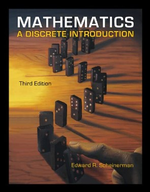Prove the following equations by induction. In each case, n is a positive integer. a. 1
Chapter 22, Problem 22.4(choose chapter or problem)
Prove the following equations by induction. In each case, n is a positive integer. a. 1 C 4 C 7 C C .3n 2/ D n.3n1/ 2 . b. 1 3 C 2 3 C C n 3 D n 2.nC1/2 4 . c. 9 C 9 10 C 9 100 C C 9 10n1 D 10n 1. d. 1 12 C 1 23 C C 1 n.nC1/ D 1 1 nC1 . e. 1 C x C x 2 C x 3 C C x n D .1 x nC1 /=.1 x/. You should assume x 6D 1. What is the correct right hand side when x D 1? The next parts are for those who have studied calculus. f. lim x!1 x n e x D 0: g. n D Z 1 0 x n e x dx: h. The nth derivative of x n is n; that is d n dxn x n D n: 2
Unfortunately, we don't have that question answered yet. But you can get it answered in just 5 hours by Logging in or Becoming a subscriber.
Becoming a subscriber
Or look for another answer
